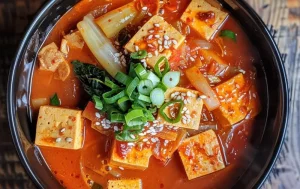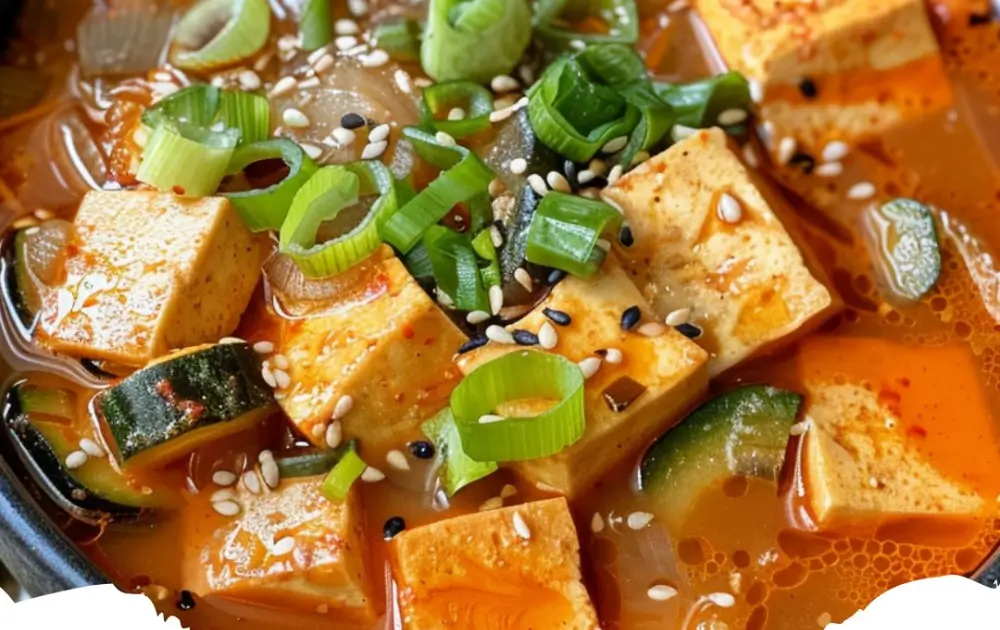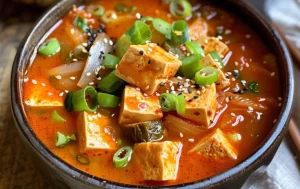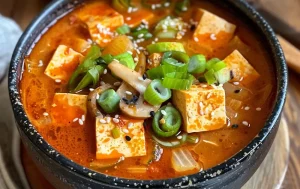Korean Tofu Soup, known as ‘Sundubu-jjigae’, originates from Korean cuisine and features soft tofu as its main ingredient. Chefs commonly prepare it with a spicy broth that includes seafood or meat. The soup is famous for its comforting warmth and rich flavors. Diners typically enjoy this dish in a stone bowl that keeps the soup hot throughout the meal. The versatility of Sundubu-jjigae allows for various ingredient combinations, catering to different dietary preferences.
Print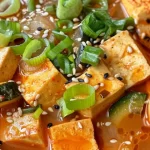
Korean Tofu Soup
- Total Time: 30 minutes
- Yield: Serves 4
- Diet: Vegetarian
Description
Korean Tofu Soup, also known as Sundubu-jjigae, is a hearty and spicy stew that features silky soft tofu, vibrant vegetables, and often includes seafood or meat. It’s a beloved comfort food in Korean cuisine, known for its rich, deep flavors and health benefits.
Ingredients
1 tablespoon sesame oil
4 cloves garlic, minced
1 onion, diced
2 tablespoons Korean red pepper flakes (gochugaru)
1 tablespoon Korean fermented soybean paste (doenjang)
4 cups vegetable broth
1 package silken tofu, cut into cubes
1 cup mushrooms, sliced
1 zucchini, sliced
1/2 cup kimchi, chopped
1 teaspoon sugar
Salt to taste
2 green onions, chopped
1 egg (optional)
Instructions
In a large pot, heat the sesame oil over medium heat. Add the garlic and onion, and sauté until they start to soften.
Stir in the Korean red pepper flakes and soybean paste. Cook for 1-2 minutes until fragrant.
Pour in the vegetable broth and bring the mixture to a boil.
Lower the heat and add the silken tofu, mushrooms, zucchini, and kimchi to the pot. Gently simmer for about 10 minutes.
Season the stew with sugar and salt. Adjust according to taste.
If using, crack an egg into the center of the stew just before serving and let it poach gently in the hot broth.
Garnish with green onions before serving.
Notes
- Adjust the spice level by varying the amount of chili powder.
- Vegetarian version: Skip seafood or meat and add more vegetables like mushrooms or zucchini.
- Always serve boiling hot for the best experience.
- Can be adapted for vegetarian, gluten-free.
- Prep Time: 10 minutes
- Cook Time: 20 minutes
- Category: Soup
- Method: Simmering
- Cuisine: Korean
Nutrition
- Calories: 250
- Sugar: 5g
- Sodium: 900mg
- Fat: 8g
- Saturated Fat: 1.5g
- Carbohydrates: 15g
- Fiber: 3g
- Protein: 25g
- Cholesterol: 75mg
Frequently Asked Questions about Sundubu-jjigae
- What is Sundubu-jjigae? Sundubu-jjigae is a popular Korean stew known for its spicy and comforting broth made with soft, uncurdled tofu. The dish often includes a variety of ingredients like seafood, meats, vegetables, and mushrooms.
- Is Sundubu-jjigae spicy? Yes, traditionally, Sundubu-jjigae is quite spicy due to the use of chili powder and sometimes fresh chili peppers. However, the spice level can be adjusted to suit individual tastes.
- Can I make Sundubu-jjigae vegetarian? Absolutely! You can easily adapt Sundubu-jjigae to be vegetarian by omitting meat and seafood and increasing the amount of mushrooms and vegetables.
- What is the best way to serve Sundubu-jjigae? Sundubu-jjigae is best served hot in a stone bowl to keep the soup warm. It’s typically enjoyed with a side of steamed rice and various Korean side dishes known as banchan.
- How long does it take to make Sundubu-jjigae? The cooking time for Sundubu-jjigae is relatively short, usually taking about 30 minutes from start to finish. This makes it a convenient option for a quick yet hearty meal.
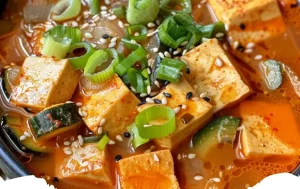
Ingredients and Variations
The primary ingredient in Sundubu-jjigae is uncurdled tofu, which offers a soft, silky texture. Cooks often add ingredients such as kimchi, vegetables, mushrooms, onion, seafood (like shrimp or clams), or meats such as beef or pork. To create the soup’s base, they use chili powder, garlic, and sesame oil, providing a distinctive spicy and savory taste. Variations might include the addition of different types of mushrooms or seafood, adjusting the spice level to suit personal tastes.
Preparation Process
The preparation of Sundubu-jjigae starts with heating sesame oil in a large pot. Cooks then sauté onions, garlic, and chili powder to develop a flavorful base. They add meat or seafood to the pot, cooking it until it’s nearly done. Next, water or anchovy stock is poured in, followed by the addition of tofu and any remaining vegetables. The soup simmers until all ingredients are thoroughly cooked and the flavors meld together. This cooking process is crucial for achieving the deep, robust taste characteristic of the soup.
Serving and Eating Sundubu-jjigae
Sundubu-jjigae is traditionally served boiling hot in a stone pot. It is common to crack an egg into the soup at the table just before eating, allowing the heat from the soup to poach the egg gently. Diners stir the egg into the soup, which thickens it slightly and adds richness. Accompaniments often include steamed rice and a selection of Korean side dishes known as banchan. The act of sharing Sundubu-jjigae from a communal pot enhances the dining experience, emphasizing Korean culinary traditions.
Cultural Significance
In Korean culture, Sundubu-jjigae is more than just a meal; it is a comfort food that embodies the warmth and hospitality of Korean cooking. It is popular in both home kitchens and restaurants, especially during the colder months, as it is believed to help warm the body and soul. The soup’s spicy nature is also thought to relieve hangover symptoms, making it a popular choice after a night of indulgence. Sundubu-jjigae’s presence on the dining table brings people together, symbolizing unity and shared comfort.
